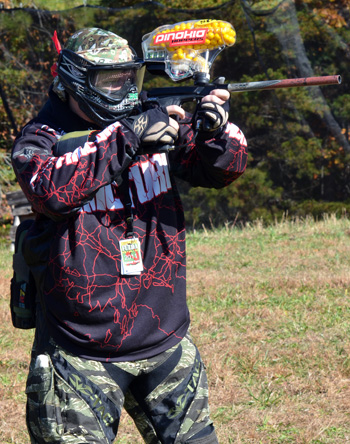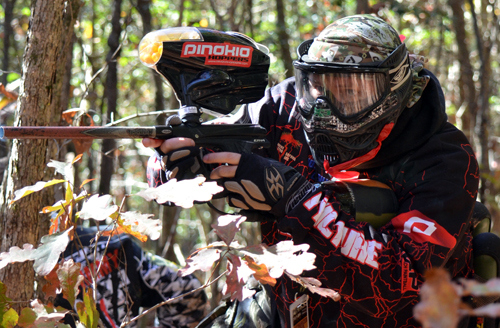Planet Eclipse ETHA
By Joshua D. Silverman
Photography by Brett Weaver of PBUprising.com and Planet Eclipse
As seen in PaintballX3 Magazine

Anyone who knows me even in-passing knows I’ve been impressed by Planet Eclipse for years, and have always enjoyed using their products on the paintball field. They probably also know that whenever Planet Eclipse brings out something new, I’m there to get a piece of that action and find out if they can keep their streak of “platinum hits” alive. So far, the people at Eclipse haven’t disappointed me. This year, however, it wasn’t a new top-end Ego, a new version of the Geo or even a new ETek that had me creeping around the Eclipse tent at the PSP World Cup, it was something else entirely: a new, entry-level paintball gun slotting into the Eclipse family lower in price than even the Etek3 LT, the Etha.
When Jacko and Ledz put an Etha in my hands at the World Cup, I was impressed, immediately, by its size and very light weight, as it very closely resembled the latest spool valve Geos in both respects. However, they explained, the Etha was not simply a polymer-framed, lower-priced Geo following in the footsteps of the Etek and its relationship to the Ego. Rather, I was shown, the Etha utilizes a robust and simple operating system not used by Eclipse before, a spring-returned bolt system that uses a pull-poppet spool to vent air from the firing chamber, simplifying the operation of the marker. The Etha is constructed of a mix of aluminum and composites, with the marker’s body cut from aluminum and its grip frame, on/off bottle adapter, clamping feed neck and eye covers made from the same glass-reinforced nylon used in similar components found on the Etek3 LT. Perhaps the best feature of the Eclipse Etha is its retail price of approximately four hundred dollars.
 The Eclipse Etha, while an entirely new marker with a new internal operating system, brings many features found on other, more expensive Eclipse markers with it into the ring that help it punch above its weight class. An off-set, clamping, low-rise feed neck is standard, helping the marker feed quickly but reliably even at high rates of fire. The offset feed neck of the marker, combined with break-beam, anti-chop eyes and a replaceable soft bolt face all but eliminate the possibility of chopped paintballs. A fully adjustable, smooth and snappy double trigger is standard, as is a simple but user-friendly on/off bottle adapter that mates to the grip frame via Eclipse’s proven t-slot system. The in-line regulator on the Etha is the proven SL3 system, as-used on the Eclipse Ego and Geo markers, while the proven, two-piece Eclipse Shaft4 barrel carries over as well, in a 14.5 inch length with a .693 bore size. Electronic firing modes present on the Etha’s board include capped and uncapped semiautomatic and ramp settings, and electric power is provided by a nine-volt battery inserted into the grip frame. The Etha is shipped in an attractive, armored plastic box complete with Allen wrenches, spare o-rings, grease and a full-color manual.
The Eclipse Etha, while an entirely new marker with a new internal operating system, brings many features found on other, more expensive Eclipse markers with it into the ring that help it punch above its weight class. An off-set, clamping, low-rise feed neck is standard, helping the marker feed quickly but reliably even at high rates of fire. The offset feed neck of the marker, combined with break-beam, anti-chop eyes and a replaceable soft bolt face all but eliminate the possibility of chopped paintballs. A fully adjustable, smooth and snappy double trigger is standard, as is a simple but user-friendly on/off bottle adapter that mates to the grip frame via Eclipse’s proven t-slot system. The in-line regulator on the Etha is the proven SL3 system, as-used on the Eclipse Ego and Geo markers, while the proven, two-piece Eclipse Shaft4 barrel carries over as well, in a 14.5 inch length with a .693 bore size. Electronic firing modes present on the Etha’s board include capped and uncapped semiautomatic and ramp settings, and electric power is provided by a nine-volt battery inserted into the grip frame. The Etha is shipped in an attractive, armored plastic box complete with Allen wrenches, spare o-rings, grease and a full-color manual.
The Eclipse Etha I was provided for testing purposes arrived at my doorstep literally moments before I hit the road for the remarkable Fulda Gap scenario game in the hills of North Carolina. Without even taking the marker out of the box, I took it from the UPS truck and placed it in my truck for the ride down. When I arrived, I got settled-in, opened the green box, pulled out the marker and headed for the chronograph. All testing, both over the chronograph and on the field, were accomplished at the 2011 Fulda Gap event, in chilly fall weather with a Pinokio hopper, Valken field-grade paintballs and a Ninja 68 cubic inch, 4,500psi bottle.
Switching the Etha on and off is accomplished via a large button at the bottom rear of the grip frame, and a user interfaces with the marker via this button and a large LED display which flashes different colors to convey various information. Taking the marker from the box to the chronograph took little more than five minutes, and most of that time was spent walking from my booth to the chronograph area. Over a radar chronograph, shooting the least expensive Valken paintballs available in 40 degree weather, the Etha delivered impressive results including a string of 279, 277, 277, 276 and 278, and a second string of 277, 279, 275, 278 and 276. These outstanding results were backed up by impressive accuracy at the small target range at the Command Decisions facility, where I was able to one and two-ball targets with little difficulty by turning the marker slightly and sighting down the barrel. The Etha points instinctually and shoots with minimal, but perceptible recoil. Noise of the firing marker is noticeable but not noisy, and the stock Eclipse Shaft4 barrel is excellent, allowing players on a limited budget to play with accuracy and confidence.
After getting my card punched for both the safety briefing and passing through the chronograph, I took to the field. Air fills at the 2011 Fulda Gap scenario were excellent, if not a little warm, as I watched my 4,500psi fill ease back to closer to 4,000 by the time my team and I got into the woods to mix it up with the NATO forces facing us across the hilly and thickly wooded terrain. We ran into sporadic resistance from handfuls of players at a time, but our “shoot and move” skirmish line allowed us to easily outflank and eliminate even the most stubborn and dug-in opponents, who in most cases chose to face us one at a time.
Moving around the field with the Etha was easy, thanks to its light weight and balance. Even with a full Pinokio hopper and a 68 cubic inch, 4,500psi Ninja bottle, the Etha was light, tight and easy to maneuver. My first elimination with the Etha impressed me, as it was accomplished while crawling, nearly prone, through thick brush at a range of roughly fifteen yards. As I crawled forward, my friend Larry shot at an opponent hiding behind two large drums and a pallet. When Larry shot at him, he tucked back into his cover, hiding behind the barrels. This exposed the player’s entire body to me, but I could only see him through the pallet that made up the rest of his bunker. I slowed my crawl and raised the Etha, holding it pistol-style in my right hand, and fired three shots. Two of those shots passed through the slots in the pallet and eliminated the player behind. The rest of my morning at Fulda Gap, playing with the Etha, passed in a similar fashion: my team and I moved forward through the trees, shooting players as we went. The Etha shot quietly, accurately and without any hiccups. Though it was chilly, the marker broke no paintballs and delivered approximately 1,000 shots on a 4,000psi fill before exhibiting noticeable drop-off.

The Planet Eclipse Etha is “entry level” in price only. The Etha is a light, small, fast, accurate, simple, reliable and feature-rich marker that will enable players on a very low budget to compete with practically anything on any field. At no point during testing did I feel disappointed in the marker or feel outgunned by any opponent I came up against at a game with over 1,000 players. My only concern is that once it officially hits the market, Eclipse may not have made enough of these impressive little paintball guns.
www.PlanetEclipse.com

